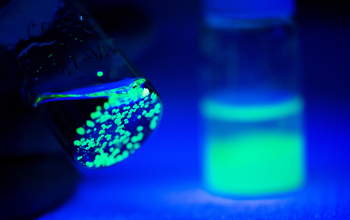Multimedia Gallery
Research on safer storage of nuclear waste (Image 1)
Uranium 238 fluoresces under black light. Research performed in the lab of University of Iowa associate professor Tori Forbes in the Chemistry Department could lead to safer storage of nuclear waste. [See related image Here.]
More about this image
A growing research enterprise at the University of Iowa (UI) is working to address nuclear energy and waste.
Funded primarily by federal grants including from the National Science Foundation, the UI program has gathered a squadron of scientists -- in chemistry, engineering and radiology -- to determine how to deal with stored nuclear waste without damaging the environment or threatening human health, and to train the next generation of scientists to study and solve the issue.
The U.S. is facing a reckoning with its spent nuclear fuel. Nuclear waste is stored across the country in water-resistant metal tubes. But many of these tubes are decades old and have become susceptible to corrosion. If the waste -- all of it radioactive -- were to escape, the damage to the environment, and to people, could be significant.
"The issue is these casks are not meant to last for that long, and our nuclear waste is so radioactive that it’s going to take hundreds of thousands of years before it decays to levels where it’s safe," says Tori Forbes, an associate professor in the Department of Chemistry at UI who established UI’s nuclear research core. "So, we need to come up with a strategy to deal with the waste where we can make sure that it’s stored safely, recycled, or reused."
Read more about this research in the UI news story University of Iowa establishes research group on nuclear energy and waste. (Date image taken: March 8, 2018; date originally posted to NSF Multimedia Gallery: Dec. 18, 2018)
Credit: Tim Schoon/University of Iowa
Images and other media in the National Science Foundation Multimedia Gallery are available for use in print and electronic material by NSF employees, members of the media, university staff, teachers and the general public. All media in the gallery are intended for personal, educational and nonprofit/non-commercial use only.
Images credited to the National Science Foundation, a federal agency, are in the public domain. The images were created by employees of the United States Government as part of their official duties or prepared by contractors as "works for hire" for NSF. You may freely use NSF-credited images and, at your discretion, credit NSF with a "Courtesy: National Science Foundation" notation.
Additional information about general usage can be found in Conditions.
Also Available:
Download the high-resolution JPG version of the image. (7.8 MB)
Use your mouse to right-click (Mac users may need to Ctrl-click) the link above and choose the option that will save the file or target to your computer.



